 W
WThis is a list of cities in India thought to have been founded before the 8th century.
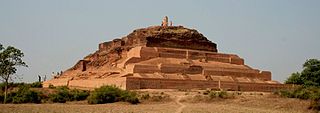 W
WAhichchhatra, near the modern Ramnagar village in Aonla tehsil, Bareilly district in Uttar Pradesh, India, was the ancient capital of Northern Panchala, a northern Indian kingdom mentioned in the Mahabharata.
 W
WAkingam is a village in South Kashmir in the Anantnag district, in the Indian union territory of Jammu and Kashmir. It is at a distance of approximately 14.2 kilometres (8.8 mi) from the Lal Chowk in Anantnag along a route passing through the tourist resorts of Achabal and Kokernag. In revenue records, the village of Akingam is still called Maqan Shiva Bhagwati. The adjacent villages are Mohripura, Hiller, Badasgam, Hardpora and Badoora.
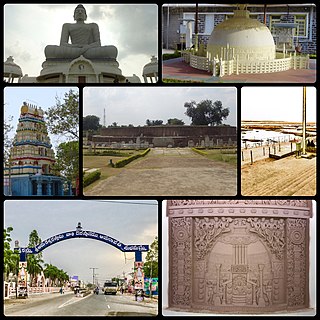 W
WAmaravathi is a town located on the banks of Krishna River, in Guntur district of the Indian state of Andhra Pradesh. It is the headquarters of Amaravathi mandal, and forms part of the Andhra Pradesh Capital Region with its headquarters at new Amaravati 35 km (22 mi) east, whose name is also borrowed from the name of Amaravathi.
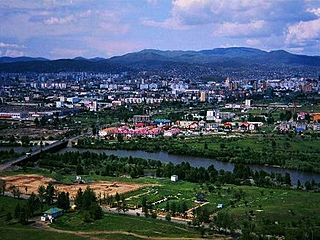 W
WAnantnag, also known locally as Islamabad, is the administrative headquarters of the Anantnag district in Jammu and Kashmir. It is located at a distance of 53 kilometres from the union territory's capital Srinagar. It is the third largest city in Jammu and Kashmir after Srinagar and Jammu with an urban agglomerate population of more than 200,000 and municipal limit population over 100,000.
 W
WAsurgarh is an archaeological site in the Kalahandi district of Odisha.
 W
WAyodhya is a city and the administrative headquarters of Faizabad district of Uttar Pradesh, India. It shares a municipal corporation with its neighbouring twin town of Faizabad.
 W
WBijbehara is a town and a notified area committee in Anantnag district of the Indian union territory of Jammu and Kashmir. It is located on National Highway NH-1 A, connecting the Kashmir Valley with the rest of India. Bijbehara town is also known as "Chinar Town" because of two Chinar gardens which are known for their Chinars trees. Bijbehara is the home to oldest chinar tree in the region. The town is situated about 45 km from the summer capital, Srinagar.
 W
WBithoor or Bithur is a town in Kanpur District, 23.4 kilometres (14.5 mi) by road north of the centre of Kanpur city, in Uttar Pradesh, India. Bithoor is situated on the right bank of the Ganga, and is a centre of Hindu pilgrimage. According to Hindu scriptures, Bithoor is the birthplace of Bhagwan Shri Ram's sons Luv and Kush. Bithoor is also the centre for War of Independence of 1857 as Nana Sahib, a popular freedom fighter who was based there. The city is enlisted as a municipality of Kanpur metropolitan area.
 W
WBrenti Bat Pora village is located in Anantnag Tehsil of Anantnag district in Jammu and Kashmir, India.
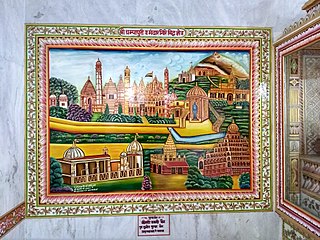 W
WChampapuri is a village in Bhagalpur district in the Indian state of Bihar. It is the site of the ancient city of Champa, the capital of the Anga mahajanapada.
 W
WChitrakoot is a famous pilgrimage centre and a nagar panchayat in the Satna district in the state of Madhya Pradesh, India. It is a place of religious, cultural, historical and archaeological importance, situated in the Bundelkhand region. It borders the Chitrakoot district in Uttar Pradesh, whose headquarters Chitrakoot Dham is located nearby. The city lies in the historical Chitrakoot region, which is divided between the present-day Indian states of Uttar Pradesh and Madhya Pradesh. It is known for a number of temples and sites mentioned in Hindu scriptures.
 W
WDachnipora is a town and a notified area committee in Anantnag district of the Indian union territory of Jammu and Kashmir.
 W
WDharanikota is a village in Guntur district of the Indian state of Andhra Pradesh. It is located in Amaravathi mandal of Guntur revenue division. The village forms a part of Andhra Pradesh Capital Region, under the jurisdiction of APCRDA.
 W
WDialgam is a large village situated in Anantnag tehsil, in Anantnag district of Jammu and Kashmir. It is one of 150 villages in Anantnag Block along with villages like Hardu Shichan and Pal Pora.
 W
WFatehpora also known as Fateh Pora & Fatehpura, is an economic hub area of Anantnag district in the union territory of Jammu and Kashmir, India.Fatehpora is located at 33.656027°N 75.160375°E. It has an average elevation of 1600 metres (5478 feet) above mean sea level.
 W
WHastinapur is a city in the Meerut district in the Indian state of Uttar Pradesh. Hastinapur, described in Hindu texts such as the Mahabharata and the Puranas as the capital of the Kuru Kingdom, is also mentioned in ancient Jain texts. Hastinapur is located on the right bank of the Ganges river.
 W
WKanchipuram, also known as Kānchi or Kancheepuram, is a temple city in the Indian state of Tamil Nadu in Tondaimandalam region, 72 km (45 mi) from Chennai – the capital of Tamil Nadu. The city covers an area of 11.605 km2 (4.481 sq mi) and had a population of 164,265 in 2011. It is the administrative headquarters of Kanchipuram District. Kanchipuram is well-connected by road and rail.
 W
WKodumanal is a village located in the Erode district in the southern Indian state of Tamil Nadu. It was once a flourishing ancient trade city known as Kodumanam, as inscribed in Patittrupathu of Sangam Literature. The place is an important archaeological site, under the control of State Archaeological Department of Tamil Nadu. It is located on the northern banks of Noyyal River, a tributary of the Cauvery.
 W
WKokernag is a sub-district town and a notified area committee in Breng Valley, Anantnag district in the Indian union territory of Jammu and Kashmir. The place is known for its gardens, pristine fresh water springs and rainbow trout farms. It is 25.3 km from Anantnag via NH244.It is one of the most popular weekend getaways from the state capital Srinagar.
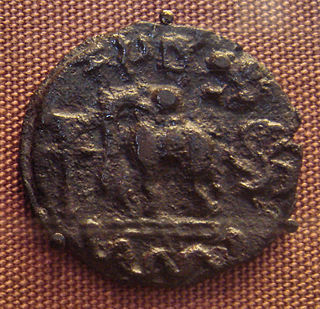 W
WKosambi (Pali) or Kaushambi (Sanskrit) was an important city in ancient India. It was the capital of the Vatsa kingdom, one of the sixteen mahajanapadas. It was located on the Yamuna River about 56 kilometres (35 mi) southwest of its confluence with the Ganges at Prayaga.
 W
WKushinagar is a town in the Kushinagar district of the Indian state of Uttar Pradesh. It is an important Buddhist pilgrimage site, where Buddhists believe Gautama Buddha attained Parinirvana after his death. It is an international Buddhist pilgrimage centre. The followers of Buddhism, especially from Asian countries, wish to visit this place at least once in their lifetime.
 W
WMadurai is a major city in the Indian state of Tamil Nadu. It is the cultural capital of Tamil Nadu and the administrative headquarters of Madurai District and Pandya Nadu, the third largest city in Tamil Nadu and 44th most populated city in India. Located on the banks of River Vaigai, Madurai has been a major settlement for two millennia.
 W
WMagadha was an ancient Indian kingdom in southern Bihar, and was counted as one of the sixteen Mahajanapadas, 'Great Countries' of ancient India. Magadha played an important role in the development of Jainism and Buddhism, and two of India's greatest empires, the Maurya Empire and Gupta Empire, originated in Magadha.
 W
WMathura is a city in the Indian state of Uttar Pradesh. It is located approximately 55 kilometres (34 mi) north of Agra, and 145 kilometres (90 mi) south-east of Delhi; about 11 kilometres (6.8 mi) from the town of Vrindavan, and 22 kilometres (14 mi) from Govardhan. It is the administrative centre of Mathura district of Uttar Pradesh. In ancient times, Mathura was an economic hub, located at the junction of important caravan routes. The 2011 Census of India estimated the population of Mathura at 441,894.
 W
WMithila is a proposed state in India, comprising the Maithili speaking region of Bihar and Jharkhand. The Maithili language has own traditional script, known as Mithilakshar. It is part of the historical Mithila region. The proposed state will also include some Angika and Bajjika speaking districts which are considered by some to be dialects of Maithili. What will be the capital city of Mithila, India is still to be decided.
 W
WMonghall is a village in Anantnag tehsil in Anantnag district in the Indian union territory of Jammu and Kashmir. It is one of 105 villages in Anantnag Block along with villages like Bagh Nowgam and Haji Danter.
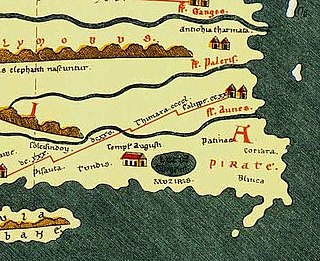 W
WMuziris was an ancient harbour and urban centre on the Malabar Coast that dates from at least the 1st century BC. Situated around present day Kodungallur exact location of Muziris is unknown to historians and archaeologists. Muziris found mention in the bardic Tamil poems and a number of classical sources.
 W
WNagari, also Nagri, is a village situated 12 km north of Chittorgarh in Rajasthan state in India. Its ancient name was Madhyamika. It was a flourishing town from the Mauryan period up to Gupta period. The old remains discovered in the excavations prove that. A large number of punch marked and other old coins have been discovered here.
 W
WPava was a city in ancient India, at the time of Mahavira and Gautama Buddha. It was a city of the Mallas which the Buddha visited during his last journey, going there from Bhogagama and staying at Cunda's mango grove. Pava is located about 15 kilometres east of Kushinagar in Uttar Pradesh, India.
 W
WPithapuram is a town and a municipality in the East Godavari district in the Indian state of Andhra Pradesh. The town also forms a part of Godavari Urban Development Authority. The town is home to one of the eighteen Maha Sakthi Peethas, which are significant shrines and pilgrimage destinations in Shaktism.
 W
WPoompugar is a town in the Mayiladuthurai district in the southern Indian state of Tamil Nadu. It was once a flourishing ancient port city known as Kaveri poompattinam, which for a while served as the capital of the early Chola kings in Tamilakam. Puhar is located near the end point of the Kaveri river, aside the sea coast. It is mentioned in the Periplus of Ereythrean sea. It is now established by marine archeological research conducted by the National institute of marine archeology, Goa that much of the town was washed away by progressive erosion and floods. Submerged wharves and several meter lengths of pier walls have excavated in recent times have corroborated the literary references to Poompugar. It was rebuilt several times after that. Ancient Pottery dating back to the 4th century BCE have been discovered off shore by marine archeologists east of this town.
 W
WPragjyotishpura, now deemed to be a region within modern Guwahati, was an ancient city and capital of the medieval Kamarupa Kingdom under Varman dynasty. The earliest mention from local sources come from the 7th century.
 W
WPuhar is a town in the Mayiladuthurai district in the southern Indian state of Tamil Nadu. It was once a flourishing ancient port city known as Kaveri Poompattinam, which for a while served as the capital of the Early Chola kings in Tamilakam. Puhar is located near the end point of the Kaveri river, aside the sea coast. It is mentioned in the Periplus of the Erythraean Sea.
 W
WPushpagiri Temple Complex is a temple complex located in Kadapa district in Andhra Pradesh, India. Founded around 7th Century CE, it houses some of the oldest temple congregations in the region. It is not to be confused with the Buddhist Pushpagiri Vihara ruins in Odisha.
 W
WQuimoh is a town situated between two districts, Kulgam district and Anantnag district, towards North of Dachnipora located in the Indian union territory of Jammu and Kashmir. The distance between Kulgam and Quimoh is 11 km where its headquarters are located. It is bounded by Devsar towards west, Anantnag city towards East, Qazigund town towards South, and Kulgam city towards west.
 W
WSagala, Sakala, or Sangala was a city in ancient India, which was the predecessor of the modern city of Sialkot that is located in what is now Pakistan's northern Punjab province. The city was the capital of the Madra Kingdom and it was razed in 326 BC during the Indian campaign of Alexander the Great. In the 2nd century BC, Sagala was made capital of the Indo-Greek kingdom by Menander I. Menander embraced Buddhism after extensive debating with a Buddhist monk, as recorded in the Buddhist text Milinda Panha. Sagala became a major centre for Buddhism under his reign, and prospered as a major trading centre.
 W
WSankissa was an ancient city in India. The city came into prominence at the time of Gautama Buddha. According to a Buddhist source, it was thirty leagues from Savatthi. After the Gautama Buddha's Mahaparinirvana king Ashoka developed this place and installed one of his famous Pillars of Ashoka in the city, from which the elephant capital survives. He also built a stupa and a temple commemorating the visit of the Buddha. This temple exists even today and the ruins of the stupa are also present as a temple of Vishari Devi. It is said that the name Visahari Devi is given to the mother of the Buddha.
 W
WShravasti was a city of ancient India and one of the six largest cities in India during Gautama Buddha's lifetime. The city was located in the fertile Gangetic plains in the present-day district of the same name, Shravasti, that belongs to Devipatan division of Uttar Pradesh near Balrampur, some 175 kilometres (109 mi) north-east of Lucknow. Earlier, it was a part of the Bahraich district, but the latter was split due to administrative reasons.
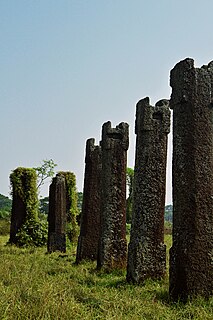 W
WSisupalgarh or Sisupalagada is situated in Khurda District in Odisha, India and houses ruined fortifications. It is one of the largest and best preserved early historic fortifications in India, with the earliest occupation both inside and outside the later site´s northern rampart around 7th to 6th centuries BCE.
 W
WTamralipta or Tamralipti was a city in ancient Bengal, located on the Bay of Bengal in Midnapore district of modern-day India in West Bengal. The Tamluk town in present-day West Bengal is identified as the site of Tamralipti.
 W
WThanesar is a historic town and an important Hindu pilgrimage centre on the banks of the Saraswati River in the state of Haryana in northern India. It is located in Kurukshetra district, approximately 160 km northwest of Delhi, and Kurukshetra's urban area now merges with Thanesar.
 W
WTiruchirappalli, also called Tiruchi or Trichy, is a major tier II city in the Indian state of Tamil Nadu and the administrative headquarters of Tiruchirappalli district. It is the fourth largest city as well as the fourth largest urban agglomeration in the state. Located 322 kilometres (200 mi) south of Chennai and 374 kilometres (232 mi) north of Kanyakumari, Tiruchirappalli sits almost at the geographic centre of the state. The Cauvery Delta begins 16 kilometres (9.9 mi) west of the city where the Kaveri river splits into two, forming the island of Srirangam, which is now incorporated into the Tiruchirappalli City Municipal Corporation. The city occupies an area of 167.23 square kilometres (64.57 sq mi) and had a population of 916,857 in 2011.
 W
WThanjavur, formerly Tanjore, is a city in the Indian state of Tamil Nadu. Thanjavur is an important center of South Indian religion, art, and architecture. Most of the Great Living Chola Temples, which are UNESCO World Heritage Monuments, are located in and around Thanjavur. The foremost among these, the Brihadeeswara Temple, is located in the centre of the city. Thanjavur is also home to Tanjore painting, a painting style unique to the region.
 W
WTulamba, is a small Town in Punjab, Pakistan. Tulamba is situated on the eastern edge of the Ravi River, between the cities of Abdul Hakeem and Mian Channu. Prior to 1985 Tulamba belonged to the district of Multan, but in 1985 it was included within Mian Channu Tehsil in the newly formed Khanewal District. Tulamba's population is nearly 50,000. The spoken language is Rachnavi Punjabi. A native of Tulamba is referred to as a Tulmabvi.
 W
WUjjain is a city in Ujjain district of the Indian state of Madhya Pradesh. It is the fifth largest city in Madhya Pradesh by population and is the administrative centre of Ujjain district and Ujjain division. It is a famous Hindu pilgrimage centre with the Kumbh Mela held here every 12 years. The famous temple of Mahakaleshwar Jyotirlinga is also located in the center of the city. An ancient city situated on the eastern bank of the Kshipra River, Ujjain was the most prominent city on the Malwa plateau of central India for much of its history. It emerged as the political centre of central India around 600 BCE. It was the capital of the ancient Avanti kingdom, one of the sixteen mahajanapadas. It remained an important political, commercial and cultural centre of central India until the early 19th century, when the British administrators decided to develop Indore as an alternative to it. Ujjain continues to be an important place of pilgrimage for Shaivites, Vaishnavites and followers of Shakta.
 W
WVaishali or Vesali was a city in present-day Bihar, India, and is now an archaeological site. It is a part of the Tirhut Division.
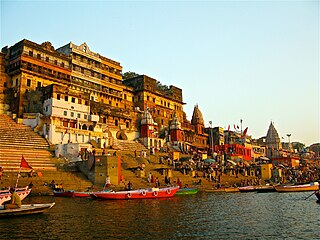 W
WVaranasi, also known as Benares, Banaras, or Kashi, is a city on the banks of the river Ganges in Uttar Pradesh, India, 320 kilometres (200 mi) south-east of the state capital, Lucknow, and 121 kilometres (75 mi) east of Allahabad. A major religious hub in India, it is the holiest of the seven sacred cities in Hinduism and Jainism, and played an important role in the development of Buddhism and Ravidassia. Varanasi lies along National Highway 2, and is served by Varanasi Junction railway station and Lal Bahadur Shastri International Airport.
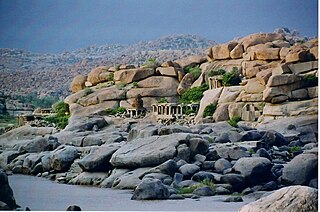 W
WThe City of Vijayanagara was the urban core of the imperial city and the surrounding principalities of the capital of the Vijayanagara empire during the 14th century to 16th century CE. Notes by foreign travellers such as Abdur Razzak, the Persian who visited Vijayanagara in 1440, mention seven fortifications before the gates to the royal palace. The large area between the first and third fortifications contained agricultural fields, gardens and residences. The notes of Robert Sewell describe countless shops and bazaars (markets) filled with people from different nationalities between this fortification and the palace.